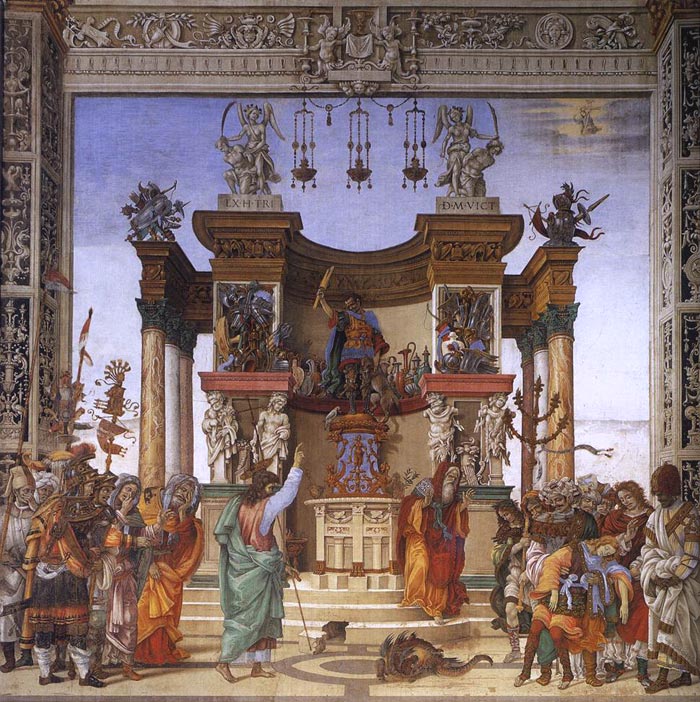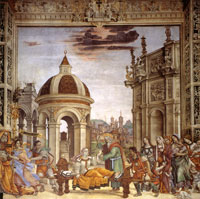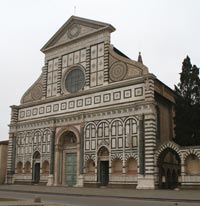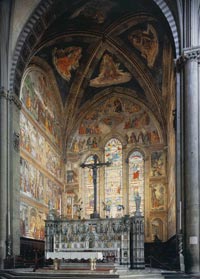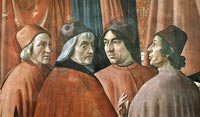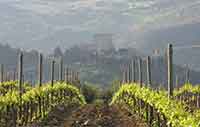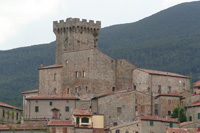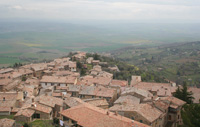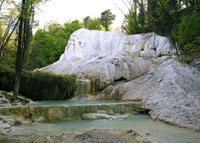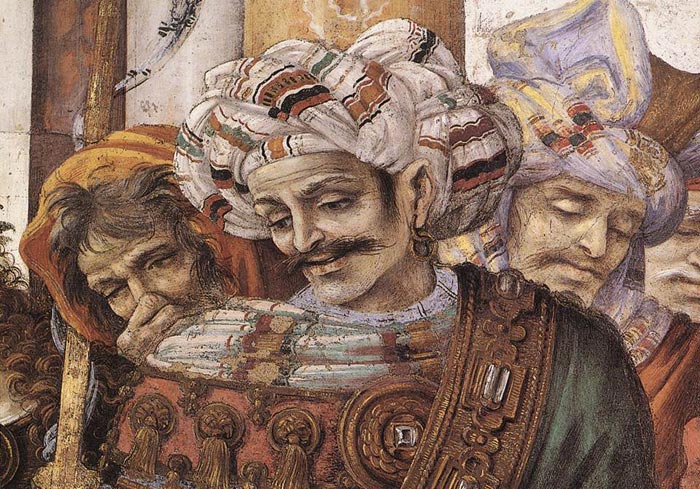 |
||||
Filippino Lippi, St Philip Driving the Dragon from the Temple of Hieropolis (detail), Filippo Strozzi Chapel |
||||
Filippino Lippi | The Strozzi Chapel in Basilica of Santa Maria Novella in Florence |
| The Basilica of Santa Maria Novella is situated in Florence, just across from the main railway station which shares its name. Chronologically, it is the first great basilica in Florence, and is the city's principal Dominican church. The church, the adjoining cloister, and chapterhouse contain a store of art treasures and funerary monuments. Especially famous are frescoes by masters of Gothic and early Renaissance. They were financed through the generosity of the most important Florentine families, who ensured themselves of funerary chapels on consecrated ground. The Filippo Strozzi Chapel is situated on the right side of the main altar. The Strozzi Chapel was the place where the first tale of the Decamerone by Giovanni Boccaccio began, when seven ladies decided to leave the town, and flee from the Black Plague to the countryside. The series of frescoes from Filippino Lippi depict the life of Philip the Apostle and James the Apostle. They were completed in 1502. On the right wall is the fresco St Philip Driving the Dragon from the Temple of Hieropolis and in the lunette above it, the Crucifixion of St Philip. On the left wall is the fresco St John the Evangelist Resuscitating Druisana and in the lunette above it The Torture of St John the Evangelist. Adam, Noah, Abraham and Jacob are represented on the ribbed vault. Behind the altar is the tomb of Filippo Strozzi with a sculpture by Benedetto da Maiano (1441). The bronze crucifix on the main altar is by Giambologna (16th century). The choir (or the Cappella Tornabuoni) contains another series of famous frescoes, by Domenico Ghirlandaio and his apprentice the young Michelangelo (1485–1490). They represent themes from the life of the Virgin and John the Baptist, situated in Florence of the late 15th century. Several members of important Florentine families were portrayed on these frescoes. The vaults are covered with paintings of the Evangelists. On the back wall are the paintings Saint Dominic burns the Heretical Books and Saint Peter's Martyrdom, the Annunciation, and Saint John goes into the Desert. The stained-glass windows were made in 1492 by the Florentine artist Alessandro Agolanti, known also as il Bidello, based on cartoons by Ghirlandaio. |
Basilica of Santa Maria Novella Address | Piazza di Santa Maria Novella, 50123 Firenze (FI) Opening hours | Open weekdays 9 a.m. - 5.30 p.m. Fridays 11 a.m. - 5.30 p.m. Saturdays 9 a.m. - 5 p.m. Sundays and religious holidays 1 p.m. - 5 p.m. |
|
||
Filippino Lippi, St Philip Driving the Dragon from the Temple of Hieropolis (detail), Filippo Strozzi Chapel |
||
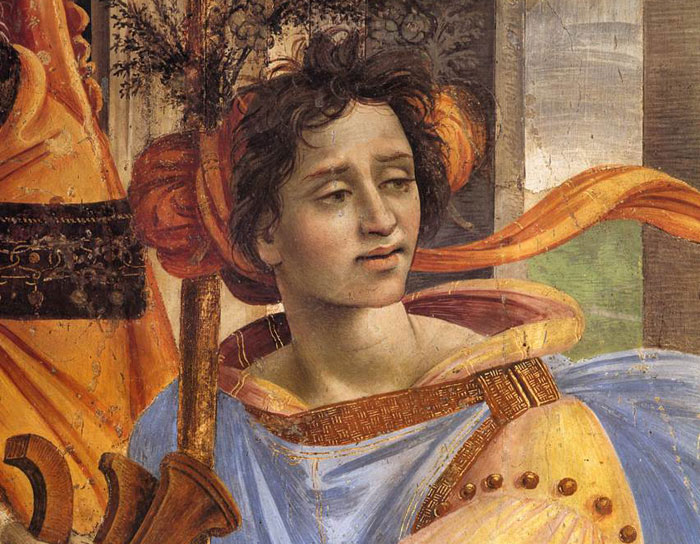 |
||
Filippino Lippi, St John the Evangelist Resuscitating Drusiana (detail), 1487-1502, fresc, Strozzi Chapel, Santa Maria Novella, Florence |
||
| The scene depicting St John the Evangelist Resuscitating Drusiana is on the left wall of the chapel. This miracle is described in the Golden Legend. It was wrought by the evangelist John in Ephesus, to which he retired after having been tortured by Emperor Domitian and banished to Patmos, where he wrote the book of Revelation. The event takes place in the foreground, there are groupings of onlookers left and right. The background is like a theatre backdrop, a cityscape filled with towers, gates, and church façades that are more evocative of central Italy than classical antiquity. Lippi patterned this composition after Giotto's depiction of the same event in the Peruzzi Chapel in Santa Croce. | ||
| The Rasing of Drusiana, by Lippi Filippino, 15th Century, pen and brown watercolor, traced of black pencil. Uffizi Gallery, Florence. |
||
Resurrezione di Drusiana |
||
|
||||
[1] The Church of Santa Maria Novellais one of the most important Gothic churches in Tuscany. The exterior is the work of Fra Jacopo Talenti and Leon Battista Alberti. The interior holds extraordinary works of art including Masaccio's Trinità, Ghirlandaio's fresco cycle in the Tornabuoni Chapel and Giotto's Crucifix, among others. Art in Tuscany | Florence | Santa Maria Novella
|
. |
|||
Holiday accomodation in Tuscany | Podere Santa Pia | Artist and writer's residency
|
||||
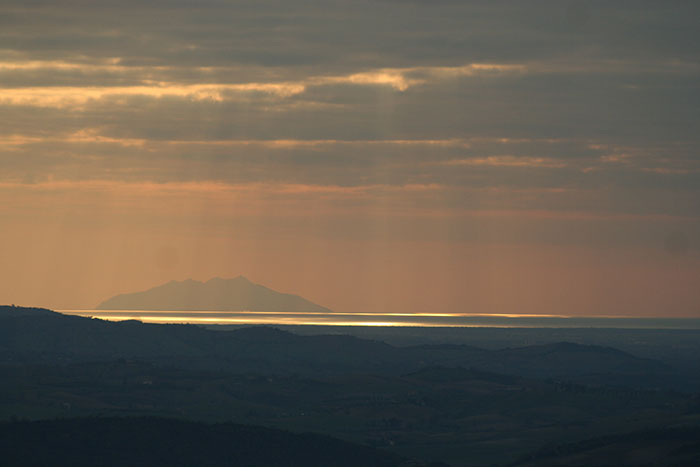 |
||||
| Evening view from Santa Pia over the Maremma hills and Monte Christo | ||||
|
||||
Podere Santa Pia |
Podere Santa Pia, garden view, December |
Bagni San Filippo |
||
Florence, besides being the capital of Tuscany, is also its most famous and beautiful city. Every year it is visited by millions of people that patiently stand in line in front of the main museums and stroll through its streets to see the main attractions. The city of Florence offers lots of things to see and to do and time is always too short. But there are several places and museums you cannot miss and which you should include in your holiday photo album. Among the top places to visit Florence is Piazza del Duomo, upon which the beautiful Duomo, or Cathedral of Santa Maria del Fiore, presides with the famous cupola or dome by Brunelleschi, the Baptistery with the bronze Gates of Paradise and Giotto's bell tower from which you can admire a stunning view of the city. Taking via dei Calzaiuoli you reach the magnificent Piazza della Signoria, center of Florence political power for centuries. Here is the grand Palazzo Vecchio, headquarters of the city government as well as museum, the Loggia della Signoria where wonderful statues such as the Perseus by Benvenuto Cellini are on display, and Neptune's Fountain by Ammannati and the equestrian statue of Cosimo I by Giambologna on the piazza itself. Right next to Palazzo Vecchio is the Uffizi Gallery, one of Italy's top museums and one of the most important in the world with its large collection of Renaissance masterpieces such as the Spring and the Birth of Venus by Botticelli, just to name a few. Connected to the Uffizi Gallery by the famous Vasari Corridor, which links Palazzo Vecchio to Palazzo Pitti, is Florence's most celebrated landmark, the Ponte Vecchio or Old Bridge. Crossing the bridge while admiring the spectacular goldsmith shops, you reach the Oltrarno area where the Pitti Palace stands magnificently and which today is the home to several splendid museums such as the Palatine Gallery and the Modern Art Gallery, with the impressive Boboli Gardens as its backyard. Not too far from Palazzo Pitti is Piazza Santo Spirito with its Church of Santo Spirito standing tall over the square with its simple and yellow facade that hides several artistic treasures inside. Going back to the Arno's northern riverbank you can admire Piazza Santa Maria Novella and the Santa Maria Novella Church with its facade in white and green marble by Leon Battista Alberti and the stunning Tornabuoni Chapel frescoed by Ghirlandaio. In Piazza San Lorenzo sneak in for a quick visit into the San Lorenzo Church, the church with its unfinished facade where the Medici family worshipped and the Medici Chapels, displaying incredible marble statues by Michelangelo. Then visit Piazza Santa Croce and its impressive Santa Croce Church where many great Florentines and Tuscans have their final resting place, including Michelangelo. On Piazzale Michelangelo, admire the breathtaking view of the city. Cities in Tuscany | Firenze or Florence |
||||

